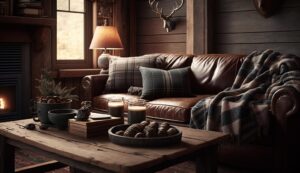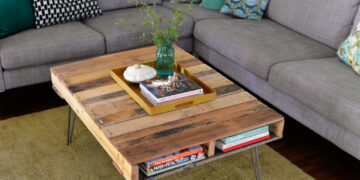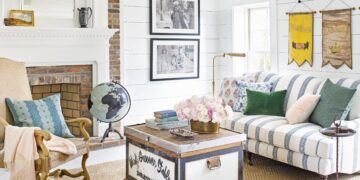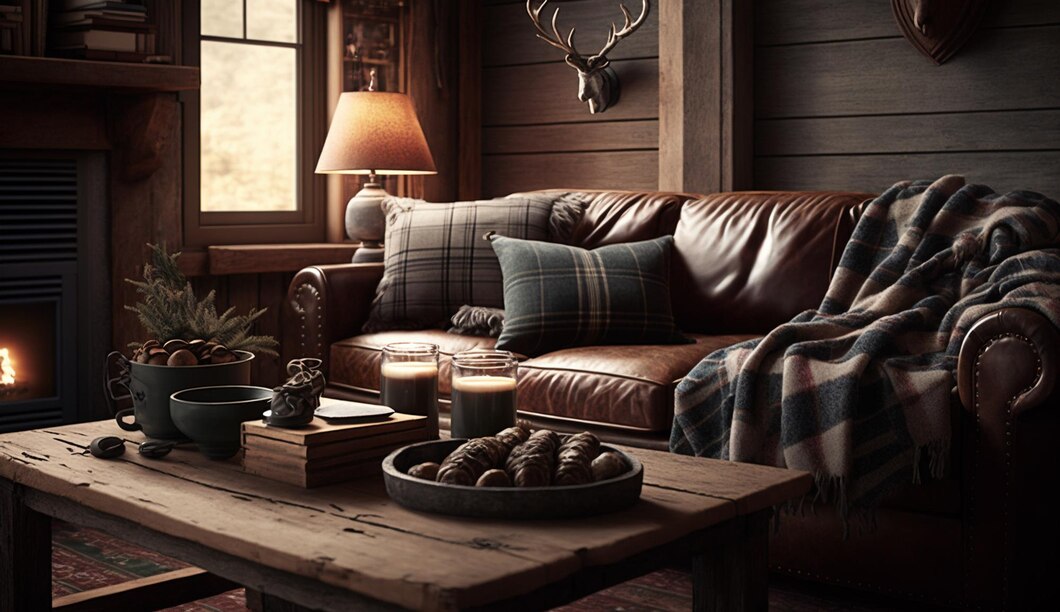Elegant Echoes: Unearthing the Timeless Allure of Antique Furniture in Modern Decor
The world of interior design is an ever-evolving realm, constantly seeking inspiration from various sources to create unique and captivating spaces. One such source that has gained immense popularity in recent years is the concept of vintage vibes in contemporary decor.
Vintage vibes encapsulate the essence of bygone eras, infusing them into modern settings to create a harmonious blend of old-world charm and contemporary aesthetics.
The Timeless Allure of Vintage Vibes
Antique furniture plays a pivotal role in adding character and charm to modern spaces. In an era dominated by mass-produced, cookie-cutter furniture, antique pieces stand out as tangible reminders of craftsmanship and individuality. They possess a certain allure that cannot be replicated by their modern counterparts.
Each vintage furniture piece tells a story; it carries with it the marks left by time, the hands that crafted it, and the lives it has witnessed. Its imperfections are not flaws but rather evidence of its journey through history.
By incorporating antique furniture into contemporary decor, we honour these stories and invite their rich narratives to intertwine with our own. Moreover, antique furniture adds depth and dimension to modern spaces by breaking away from standard design conventions.
Its presence creates visual interest and acts as a focal point, commanding attention in an otherwise uniform environment. The juxtaposition between old-world elegance and sleek modernity creates a captivating atmosphere that sparks conversation and evokes emotions.
In today’s fast-paced world, where trends come and go swiftly, vintage vibes offer a haven for those seeking lasting beauty amidst fleeting fads. They remind us to slow down, appreciate the artistry of yesteryear, and find solace in timeless aesthetics.
Understanding Vintage Vibes
Definition of vintage vibes and its significance in interior design
Vintage vibes refer to the aesthetic and ambience that antique furniture brings to contemporary spaces. It encompasses the nostalgia and charm associated with bygone eras, invoking a sense of history and timelessness.
In interior design, vintage vibes hold immense significance as they add depth, character, and a touch of authenticity to modern decor.
They allow individuals to create unique spaces that reflect their personality and personal style while paying homage to the past. Exploring the nostalgia factor and emotional connection with antique furniture
Antique furniture holds a captivating power that transcends time. It evokes nostalgia by connecting us with memories of our ancestors or eras we have only heard about through stories or books.
There is an undeniable emotional connection formed when we interact with these pieces—running our fingers over smooth wood finishes worn by generations before us or envisioning the conversations had around a well-worn dining table.
Antique furniture allows us to become part of a larger narrative, providing a tangible link between past, present, and future generations. The emotional resonance it carries can transport us to another era while grounding us in our current reality.

The Timeless Appeal of Antique Furniture
Antique furniture possesses an undeniable allure that transcends time. It serves as a portal to history, carrying with it the stories and craftsmanship of bygone eras. Exploring the different periods in antique furniture reveals a rich tapestry of styles, each with its unique characteristics.
Victorian Era: Ornate Designs, Dark Woods, and Intricate Carvings
The Victorian era, spanning from the early 19th century to the beginning of the 20th century, is renowned for its opulent designs. In this period, furniture became a symbol of wealth and social status.
Elaborate ornamentation was at the forefront, with dark woods such as mahogany and walnut being favoured for their richness and depth.
Intricate carvings adorned chairs’ legs, tables’ edges, and dressers’ surfaces. The Victorian aesthetic exuded a sense of grandeur through its attention to detail in every aspect.
Art Deco Period: Geometric Shapes, Bold Colors, and Luxurious Materials
The Art Deco period emerged in the 1920s and 1930s as a reaction against the ornate styles of previous eras. It celebrated modernity with its sleek lines and geometric forms.
Art Deco furniture often featured strong contrasts between light and dark woods like rosewood or ebony. The use of bold colours, such as vibrant blues or striking reds, added drama to these pieces.
Luxurious materials like mirrored glass or inlaid metals further elevate their lavish appeal. This era represented an aesthetic shift towards streamlined elegance.
Mid-century Modern: Clean Lines, Organic Forms, and Functionality
The mid-century modern period emerged after World War II, when designers sought to create functional yet aesthetically pleasing furniture. This movement, which lasted from the 1940s to the 1960s, embraced simplicity and minimalism. Clean lines and organic shapes were prominent, focusing on showcasing the natural beauty of materials like teak and walnut.
Mid-century modern pieces prioritized functionality, introducing innovative features such as built-in storage or modular components. This era still captivates contemporary audiences with its timeless design principles.
While each era possesses its visual language, there is a common thread that unites them all: enduring craftsmanship and quality.
Antique furniture was crafted with meticulous attention to detail by skilled artisans who understood the value of longevity.
The sturdy construction and longevity of these pieces are testaments to their durability and functionality throughout the years. Today, these vintage treasures continue to fascinate collectors and interior enthusiasts alike as they bring a touch of history into modern homes.

Integrating Antique Furniture into Contemporary Spaces
Harmonizing Contrasting Elements for a Balanced Look
When incorporating antique furniture into contemporary spaces, it is crucial to strike a harmonious balance between the old and the new. One approach is to identify key elements in your existing decor style that can complement the antique piece you wish to introduce.
For instance, if your contemporary space features clean lines and neutral tones, consider selecting an antique item with similar qualities, such as a streamlined mid-century modern chair or a simple yet elegant antique desk. By finding common ground between contrasting elements, you can create visual harmony in your space, ensuring that the vintage piece seamlessly merges with its contemporary surroundings.
Mixing Different Eras to Create an Eclectic Aesthetic
For those who crave more daring and eclectic interiors, mixing different eras of furniture can result in a captivating aesthetic. This approach allows for unique storytelling within your space by combining contrasting styles and designs.
Imagine pairing a vintage Victorian armchair upholstered in luxurious velvet with a sleek and modern glass coffee table. The juxtaposition of ornate details against minimalist lines creates an intriguing dynamic that captures attention while showcasing an appreciation for the past and present simultaneously.
Tips for Incorporating Antique Furniture Seamlessly
Pairing Vintage Chairs with a Modern Dining Table for an Interesting Contrast:
One way to infuse vintage charm into your dining area is by mixing vintage chairs with a modern dining table. Consider selecting chairs from the same era or design family but with varying finishes or upholstery fabrics.
This will create an intriguing contrast while maintaining cohesiveness throughout the space.
For example, you could place four vintage Windsor-style wooden chairs around a sleek glass or marble tabletop—a perfect blend of rustic warmth and contemporary sophistication.
Using an Antique Chest as a Statement Piece in a Minimalist Bedroom:
In a minimalist bedroom where simplicity reigns, incorporating an antique chest as a statement piece can add character and depth. Choose a chest with exquisite craftsmanship and unique features that align with your overall aesthetic. Place it against a clean, white wall to create an eye-catching focal point.
Consider using the antique chest not only for storage but also as a surface to display carefully curated decorative objects or to showcase your favourite books. This fusion of functionality and aesthetics will serve as a conversation starter while bringing vintage flair to your serene sleep sanctuary.
By thoughtfully selecting the right pieces, balancing contrasting elements, and experimenting with mixing different eras, you can seamlessly integrate antique furniture into contemporary spaces. This deliberate approach ensures that vintage vibes become an integral part of your overall decor style rather than feeling like mere afterthoughts or out-of-place relics in modern surroundings.
Restoring Antique Furniture: Preserving History with Care
Explaining the importance of proper restoration techniques:
Antique furniture holds within its timeworn surfaces the stories of a bygone era. Preserving these pieces not only maintains their aesthetic value but also honours the historical significance they possess.
Proper restoration techniques ensure that each item is treated with the utmost care, allowing its original charm to shine through while addressing any structural issues. Be it a delicate Victorian chair or an Art Deco sideboard, understanding and implementing appropriate restoration methods is essential to maintaining the authenticity and integrity of these cherished heirlooms.
Respecting original finishes while addressing structural issues
One crucial aspect of restoring antique furniture revolves around respecting and preserving its original finishes. These finishes, whether they be aged patina, gilding, or hand-painted details, contribute significantly to the unique character and allure of each piece.
Skilled restorers employ meticulous techniques to clean and repair without compromising or eradicating these precious vestiges of history. By delicately addressing any structural concerns, such as loose joints or damaged veneer, they breathe new life into the furniture while ensuring the preservation of its authentic appearance.
Seeking professional help when necessary to maintain authenticity
While DIY approaches can be rewarding for simple maintenance tasks, seeking professional help is advisable when dealing with valuable antique furniture. Restoration experts possess an extensive knowledge base acquired through years of experience working on various styles and eras.
Hiring a skilled craftsman ensures that each restoration decision aligns with both the historical context and the individual piece’s unique needs. Their expertise helps safeguard against unintentional damage or irreversible alterations that could compromise the authenticity and value of the antique.
Tips for DIY restoration projects: Cleaning techniques for different types of wood or metal
For those who are inclined towards taking a hands-on approach, DIY restoration projects can be both fulfilling and cost-effective. Proper cleaning techniques are crucial steps in these endeavours, particularly when dealing with different types of wood or metal. Gentle dusting and dry cloth wiping are suitable for fragile surfaces, while mild soap solutions can be used sparingly to remove grime or sticky residue.
Carefully selected wood polishes or natural oils applied with soft cloths help restore lustre and nourish the timber. Metal components benefit from specialized cleaners, followed by rust prevention treatments to maintain their shine.
Tips for DIY restoration projects: Replacing damaged parts without compromising integrity
In some cases, antique furniture may have damaged or missing parts that require replacement. While it is essential to retain the original components whenever possible, sometimes the integrity of a piece can be compromised due to severe damage. When replacing parts becomes necessary, meticulous attention must be paid to sourcing materials that closely match the original design in terms of style, finish, and age.
Skilled DIY enthusiasts should ensure that any replacements seamlessly integrate into the overall aesthetic while maintaining respect for the piece’s authenticity. Restoring antique furniture is an art form that demands patience, skilled techniques, and a deep appreciation for history’s elegance.
By adhering to proper restoration practices—respecting original finishes while addressing structural concerns—these precious heirlooms can continue captivating hearts and minds for generations to come. Whether relying on professional expertise or embarking on DIY adventures, always remember: preserving authenticity ensures these timeless treasures will endure as living testaments to our rich heritage.
The Hunt
Unearthing Hidden Gems: The Thrill of the Search
The hunt for antique furniture is a captivating adventure that takes you on a journey through time. It begins with researching reputable antique dealers, local auctions, flea markets, and online platforms specializing in vintage pieces. As you embark on this quest, be prepared to enthusiastically explore dusty attics, dimly lit basements, and even quaint countryside shops.
Rummaging through these treasure troves can lead to discovering remarkable finds that hold stories from bygone eras. Keep an open mind and allow yourself to fall in love with unexpected pieces that resonate with your soul.
The Art of Negotiation: Finding the Perfect Price
Once you have identified your desired piece, negotiating the price becomes an integral part of the process. Polishing those bargaining skills will help you strike a fair deal while also respecting the value of the furniture. Engage in friendly conversations with dealers or sellers to gain insights about the history and provenance of the piece.
This knowledge will give you leverage during negotiations. Remember, it’s not just about securing an excellent price but also establishing a connection with fellow enthusiasts who share your passion for antiques.
Preserving and Displaying Your Treasures: Creating Your Vintage Haven
After acquiring your coveted antique furniture, it’s time to create a space where its beauty can truly shine through. Consider incorporating complementary elements such as vintage-inspired wallpaper, soft lighting fixtures reminiscent of past eras, and carefully curated accessories like vintage artwork or antique trinkets.
Arrange your newly acquired gems strategically within your living spaces to highlight their unique features while ensuring they harmonize effortlessly with contemporary elements. By seamlessly blending old-world charm with modern sensibilities, you’ll create an environment where each piece tells its own story while contributing to a cohesive design narrative.
Conclusion
Vintage furniture offers a remarkable opportunity to infuse contemporary spaces with history, personality, and a touch of nostalgia. The hunt for these timeless treasures not only enlivens our spaces but also reconnects us to the craftsmanship and artistic sensibilities of the past.
By carefully selecting, restoring, and integrating antique furniture into our modern decor, we enable ourselves to embrace an eclectic aesthetic that celebrates both tradition and innovation. So let us embark on this journey together, rediscovering the charm of vintage vibes and reveling in the joy of turning back time while moving forward.














